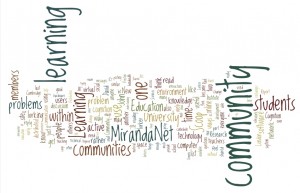A Learning Community
- Learning
- Beyond Collaborative Learning
- From practice to praxis
- ICT CPD Landscape Review
- ICT delusions: Plus Ça Change?
- Is teaching a technology, or is it more than that?
- Learning in Liminal Spaces
- Learning in Liminality
- MirandaMods
- Online forums as resources for teacher professional development
- A Learning Community
- The Role of Web-based Communities in Teacher Professional Development
- A City Learning Centre
Traditional models of learning have reified into concepts of learning, with the teacher frozen as the embodiment of skills and knowledge that have to be passed on to students. In the United Kingdom, the New Opportunities Funding CD-ROM, produced to develop teachers’ ICT curriculum competence, was the embodiment of that viewpoint at the junction of the 20th and 21st centuries.
The pace of change in industry and technology had burst through into schools. The syllabus had been expanded to the point of absurdity: the application of knowledge became a critical issue for those who navigated these shoals as captains of industry. Just-in-Time became the watchword for Learning, as it was in industry. Whereas Industry had re-engineered itself, however, Education, like Lot’s Wife, looked backwards.
The pace of change often means that teachers carry a train of conceptual baggage, with expectations as to what should be taught and why it should be taught. These conflict with students as practitioners, who battle with the teachers and academics who act as the gatekeepers over what constitute standards.
Knowledge is seen as contained in artefacts – ‘knowledge artefacts’, whereas for many students knowledge is contained within the artefacts of production: the artefacts produced.
The MirandaNet community consists of teachers and academics as practitioners, who embody the problems faced by their students at the bleeding edge of technology. Within this community cognition is manifested as both materiel and social. New technology is both the network for communication and also the collective memory of the community.
The website acts as the repository of memory: newsletters, case studies, the forum for meetings, workshops and conferences; the source of expert knowledge, with the posting of questions and collaborative learning.
This paper examines the ways in which MirandaNet, as the social construction for how we learn and why we learn, forms the focus for life-long learning. The distributed cognition manifested within this grouping of practitioners disseminates into the wider structures of education.
This paper was originally published as:
Cuthell, J. P. (2002). A Community of Learners In: Distributed Cognition Karasavvidis I (ed.). Journal of Interactive Learning Research. 13 (1/2) (pp. 169–188) Association for the Advancement of Computing in Education Norfolk, VA
